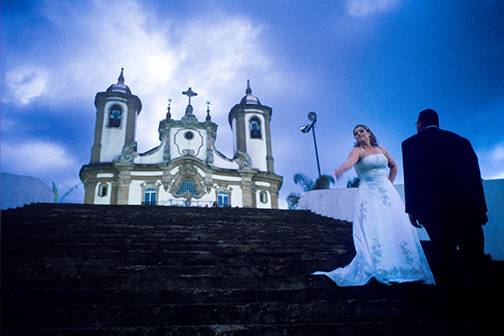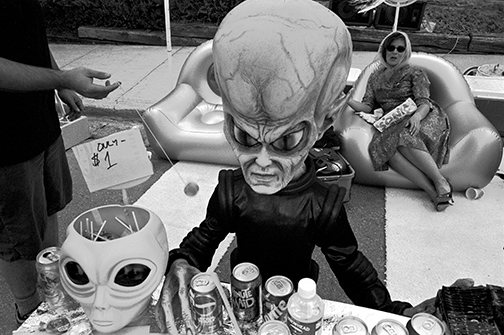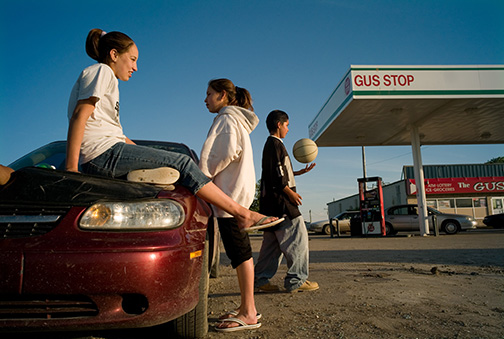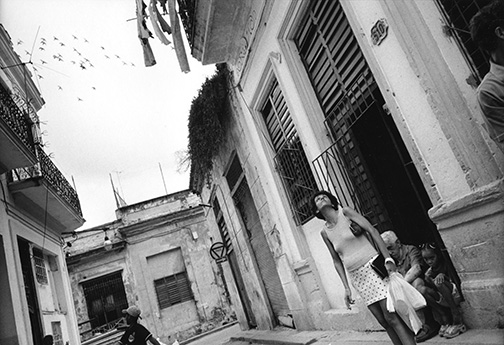
School boys in the Amazon port city of Manaus leap from fishing boats into the Rio Negro below a central city market. The Rio Negro enters the Rio Solimões at Manaus to form the Brazilian Amazon. © Kevin Moloney, 1995
Henri Cartier-Bresson… Garry Winogrand… Helen Levitt… Robert Frank… André Kértész… William Klein… Jacques Henri Lartigue… Marc Riboud… Raymond Depardon… Elliot Erwitt… Joel Meyerowitz…
I started this list as I thought of who all the great street photographers might be. But I stopped early, realizing that in photojournalism (or any of its other pseudonyms) we all photograph life in the street.
Some of these photographers have made street photography the central aspect of their work, like Winogrand and Levitt. For others, like Frank and Klein, it is the piece of a complex work puzzle that made them most famous, or led to other opportunities.
It started when I was asked recently by student Danielle Alberti:
“The second you put the camera up to your eye, it seems strangers suddenly become very aware of you, and often suspicious. And because it’s in public, it’s rare that you’ll have enough time for them to relax. So we often find ourselves doing the subtle ‘lower the camera and hope autofocus works’ trick. Of course, when this trick works, I think it works well. But do you have any other street photography suggestions that might help when you want to photograph an interesting stranger without disturbing the scene (or pissing someone off)?”
This is a very common problem for young photographers (and old). We love how photographing someone pulls us into their world. But street photography can feel a bit more like an attack, or sniping. You’re often making images without explicit nor even tacit approval.
This is also the single hardest thing to which young students of photojournalism must adjust. Even those who have worked cameras for years grew up posing family or making live images of friends with whom they are comfortable. Then I come along and ask them to hunt. It’s an initially daunting task.

A bride poses for pre-nuptial photos near the Church of Nossa Senhora da Conceição, or Our Lady of the Immaculate Conception, in Ouro Prêto, Brazil. © Kevin Moloney, 2009.
Many sense that the world has changed and the streets are meaner to a camera than in the past of Cartier-Bresson, Levitt and Evans. I do agree that there was perhaps a sweet spot, when cameras were familiar enough and photos not easily published in a way that the subject would feel harmed. There may be some truth in the idea that today, with the Web’s ubiquity and possibility, that any image can affect or harm you.
Maybe today, a camera can steal your soul more easily than before.
But I think this is only a partial truth. On any given street, in any time, you could find the camera-suspicious alongside the camera-nonchalant. The situation hasn’t changed that much. And official restriction on images has waxed and waned throughout photography’s two centuries.
So how did the greats act on the street?
Wait, watch, shoot. Cartier-Bresson was the cat. “Like an animal and a prey,” he said in The Decisive Moment, an educational program produced by the ICP and Scholastic in the 1970s. A nervous hunter, he scanned the world in front of him to anticipate the moment where something slight or something grand would unfold.
“That’s why it develops a great anxiety, this profession. because you’re always waiting… what’s going to happen? What what what what?
In photography you’ve got to be quick quick quick quick. Like an animal and a prey, braaam like this. You grasp it and you take it and people don’t notice that you’ve taken it.
I’m extremely impulsive. Terribly. It’s really a pain in the neck for my friends and family. I’m a bunch of nerves, but I take advantage of it in photography. I never think. I act. Quick.”
Cartier-Bresson was as subtle as he was quick, carrying one small camera and typically one small lens. He often saw a setting and waited patiently for a character or moment to complete the scene, making only a frame or two. “You shouldn’t overshoot,” he said. “It’s like overeating or overdrinking. You have to eat, you have to drink, but over is too much. Because by the time you press and arm the shutter once more, and maybe the picture was in between.”
Granted, now we have cameras that can make more than ten frames per second. How could you miss?

Travelers pass a Tyrannosaurus Rex display at Pittsburgh International Airport advertising the Carnegie Museum of Natural History. © Kevin Moloney, 2007.
You miss by becoming a massive presence on the street. The big cameras that do that can be intimidating enough. But add to that the assaulting power of a motor advance ripping at you like a machine gun, and suddenly everyone feels attacked rather than honored by the image.
Indeed we may soon find that some of the most important street images are being made with ubiquitous and inoffensive cell phones.
If Cartier-Bresson was the cat slipping elegantly and unnoticed from portico to portico on the street, Garry Winogrand was the nervous, fast-walking, bemused, gleeful, grunting American bear rumbling down the sidewalk.
His approach was as different from the French style as his images were. He waded into the stream of street traffic and deftly snatched salmon from the upstream flow.
Joel Meyerowitz described working the streets with Winogrand in Bystander: A History of Street Photography:
“Yeah. Oh yeah. You know, he set a tempo on the street so strong that it was impossible not to follow it. It was like jazz. You just had to get in the same groove. When we were out together, I wasn’t watching him — we were both watching the action around us — but I did pick up on his way of working and shooting. You could see what it was in his pictures. They were so highly charged, all you had to do was look at them and you began to assume the physical manner necessary to make pictures. They showed you right away that they were an unhesitating response.
Walking the streets with Garry gave me clues to being ready, to just making sure that I was. I had been a third baseman, so being ready came naturally. I was a quick study on that stuff, darting and twisting and the kinds of moves that were necessary to get a picture.
You know, if you hesitate, forget it. You don’t have but a fraction of a fraction of a second. So you have to learn to unleash that. It was like having a hair trigger. Sometimes walking down the street, wanting to make a picture, I would be so anticipatory, so anxious, that I would just have to fire the camera, to let fly a picture, in order to release the energy, so that I could recock it. That’s what you got from Garry. It came off him in waves — to be keyed up, eager, excited for pictures in that way.”
Winogrand was so keyed up about making photographs that he is said to have left behind 2,500 rolls of undeveloped film and 300,000 unedited images at his death in 1984.
With those numbers you might have expected him to have loved the motor drive. But he used the same little rangefinder cameras as Cartier-Bresson, Robert Frank and others. He was just a relentless hunter.

A boy walks below artfully painted walls in the village of Pucará, Bolivia. Ernesto “Che” Guevara was captured by the Bolivian army in 1967 in a nearby valley and executed in nearby La Higuera days later. © Kevin Moloney, 2004.
He also moved quickly, pushing his Tri-X film to ISO 1200 and higher so he could shoot a 1,000th of a second shutter speed at f/16 and never miss a moment from blur or focus. He did this through much wider angle lenses than Cartier-Bresson. He marched down the street, straight toward his subjects and whipped up the camera the moment he or they passed. It was like a surprise punch. He wouldn’t stop, wouldn’t look and wouldn’t engage. He simply marched on with a bemused smile.
Of course, in my classes he would also be forced to engage with subjects in ways he didn’t. I require IDs and full captions to build reporting skills and skills of engagement with subjects. The game changes when you must shoot at, then talk to, a subject.
Winogrand’s work is amazing, visceral and live. But it did not need the journalist’s caption. “I don’t have anything to say in any picture. My only interest in photography is to see what something looks like as a photograph. I have no preconceptions.”
Helen Levitt, who died only last year at 95, had an eye for busy streets. Though the famously private Levitt said little about her working methods, she did tell New York Times photo critic Sarah Boxer in various interviews, “You’re talking about the past, honey. I’ve been shooting a long time.”
When asked if she followed people to photograph them, the nonagenarian said, I don’t know. Maybe. I don’t remember following anybody.”
“I go where there’s a lot of activity. Children used to be outside. Now the streets are empty. People are indoors looking at television or something.
The streets were crowded with all kinds of things going on, not just children. Everything was going on in the street in the summertime. They didn’t have air-conditioning. Everybody was out on the stoops, sitting outside, on chairs.
In the garment district there are trucks, people running out on the streets and having lunch outside.”

Cuban elementary students line up in martial form after a field trip through the city. In Cuba, the land of party-run TV, nobody stays in to watch television. © Kevin Moloney, 2001.
Was she disarming? Maria Morris Hambourg, curator of photographs at the Metropolitan Museum of Art tells NPR’s Melissa Block, “She’s very quiet. She’s like a cat — very slight. She moves softly. There’s no imposition of a mood or a tone or a need. If the picture didn’t present itself she would not have ever forced it.”
But Levitt did admit to Block that she used a right-angle lens from time to time, deceiving people around her about where her camera was aimed.
Perhaps Helen Levitt simply made a natural act of photographing on the street, analyzing not the act but the result.

A local theater troupe promotes an upcoming show at a Lafayette, Colo., street fair. © Kevin Moloney, 1999.
So how do you roll, then, looking for Cartier-Bresson’s complex fleeting moments, Winogrand’s sanguine street document, Frank’s dark beat poem or Levitt’s sensitive and charmed glance?
Body language is everything. We have a choice of being quick like Cartier-Bresson, elusive like Winogrand, or disarming like Levitt.

A young girl in traditional Indian dress dances through Cuzco’s Plaza de las Armas as her brother hangs onto the family dog at rear. The kids were put on display for their mother to attract alms from passers-by. © Kevin Moloney, 1996.
Carry yourself with sincerity no matter what method you might choose. If you appear to have the right to be there with a camera, passers-by will assume you do. If you relax, appear to be having fun and mean no harm, you might be more easily tolerated.
Let your intent for photographing appear on your face. If you are charmed by someone’s antics, smile as you photograph. If moral outrage shared with a subject drives you, carry yourself with concern and sincerity.
Never appear critical, unless you are as big as Garry, as surly as Weegee or as fleet as Henri.
When caught, engage. Walk up with a charmed smile and explain who you are and why you’re photographing.
Be ready to share. Offer images to your subjects and they will feel less like they’ve been exploited. Give them your e-mail address. Don’t ask for theirs.

Teens Ariel Farmer, 14, left, Kyla Sharp Butte, 14, center, and Will Sharp Butte, 15, hang out on the hood of a car in the parking lot of a convenience store to pass time on the Rosebud Sioux Reservation in southern South Dakota, Thursday, May 24, 2007. An epidemic of teen suicides and attempts has reservation adults worried. Making these images caused a worried father — even one to whom I had introduced myself — call the tribal police. © Kevin Moloney, 2007.
Expect the protective concern of parents. Children are one of the most fun of street subjects because they live their young lives with little restraint or self- consciousness. But thanks to the creeps out there, they may fear for their child’s present and future safety when someone makes a picture.
Photograph those kids just the same, if possible without affecting the scene by asking first. But as you do, glance around for parents, and if found, make eye contact as soon as possible with a nod and a smile. As soon as you can, introduce yourself and offer a business card and copies of the pictures. Proud parents will love the images and trust more the person who is unafraid to say hello.
If there are no parents apparent, ask the children where they might be and find them. If unfound, give the child a card, because Johnny or Mary will surely talk about “that nice bearded photographer with the sunglasses who took pictures of me in the park.” You’re asking for calls to the police if they don’t know who you might be.
But there is no specific recipe for success. You will surely find fun, pleasant and trustworthy people who feel honored by your attention. And even the most bright-faced young photographer with the biggest smile will encounter people accusing her of being a freak, a creep or a terrorist.

Pigeons fly overhead as a Havana resident looks up to gauge the day’s weather. © Kevin Moloney, 2001.
Get your street legs by photographing public events. People are not surprised by being photographed for no apparent reason at a parade, festival or event. Then take your confidence out to the everyday world.
Though you have a right to photograph on the street in the U.S. and most places, when you encounter resistance, apologize and walk away with a smile. You’ll never convince them of your rights anymore than they will convince you with their indignation.
Make those images. Explore the visions and moments of the street and leave a document of the 21st century as valuable as the one our predecessors left of the 20th.
…Michael Ackerman… William Albert Allard… David Alan Harvey… Werner Bischof… David “Chim” Seymour… Weegee… Edouard Boubat… Willy Ronis… Bruce Davidson… Jodi Cobb… Walker Evans… Josef Koudelka… Ben Shahn… Martine Francke… Roy DeCarava… Miguel Rio Branco… Leonard Freed… Antonin Kratochvil… Manuel Alvarez Bravo… Dorothea Lange… Marion Post Wolcott… Dan Weiner… Wayne Miller… Diane Arbus… Graciela Iturbide… Danny Lyon… Berenice Abbott… Martin Parr… Eugene Richards… Larry Towell… Alex Webb… Sylvia Plachy… Lee Friedlander…
###
Others have written at length on this subject and their work is a valuable resource. For further reading have a look at:
Bystander: A History of Street Photography, by Colin Westerbeck and Joel Meyerowitz
Thames and Hudson, London, 1994


#1 by Mike Moloney on August 4, 2010 - 7:10 am
You are outstanding, Kevin, in your willingness to share, and guide. And you professionalism and ethics blast forth like fireworks. You certainly bear our name with great pride, and instill it in the rest of us who can bask in your sidelights.
LikeLike
#2 by Molly Maher on October 26, 2010 - 9:59 am
This, coupled with your more recent entry on “Being Present,” is just the pep talk I was yearning for after being berated in The Gambia this month. Apparently where I am, everyone thinks I am selling images of them and will literally call a mob to stop foreigners on the street from taking photos.
Great writing and information. Thanks, Kevin!
LikeLike